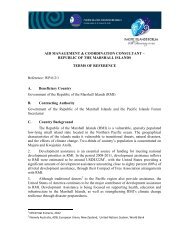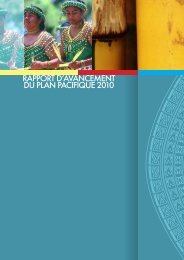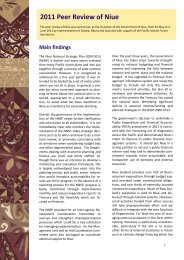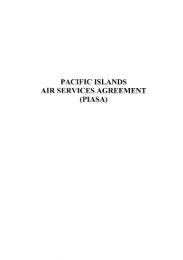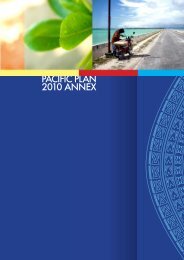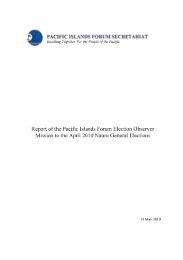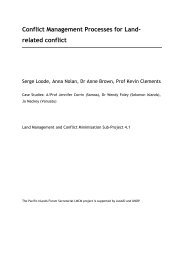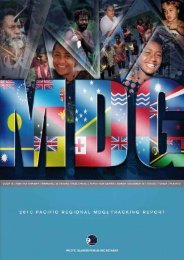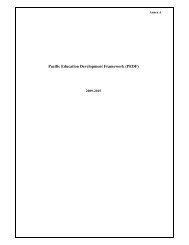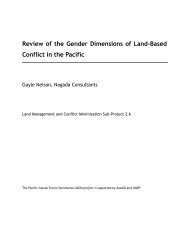PNG Introduction
PNG Introduction
PNG Introduction
You also want an ePaper? Increase the reach of your titles
YUMPU automatically turns print PDFs into web optimized ePapers that Google loves.
42 PAPUA NEW GUINEA<br />
INTRODUCTION<br />
PAPUA NEW GUINEA (<strong>PNG</strong>) is the second largest island country in the world, consisting<br />
of the eastern portion of the island of Papua, and more than 500 smaller islands.<br />
It is remarkable both for the variety and ruggedness of its terrain, and for the cultural<br />
diversity of its population of 6 million, who together speak over 700 languages (more<br />
than 10% of the global total). The population growth rate is 2.1% per annum.<br />
In 2006, the country had a gross national income (GNI) of USD 2 410 per capita<br />
(in purchasing parity terms), which classes it as a low-income country. There are no<br />
recent estimates of dollar-per-day poverty, but national poverty estimates show a rising<br />
trend, to 54% in 2005. It is deemed “very unlikely” that <strong>PNG</strong> will meet any of the<br />
globally defined Millennium Development Goal (MDG) targets, but it may “potentially”<br />
meet targets tailored to the country context for MDGs 1 to 5. Achievement on<br />
HIV/AIDS and environmental sustainability remains very unlikely.<br />
While conflict on the island of Bougainville appears to have been resolved, the<br />
country faces many challenges, particularly in the areas of HIV/AIDS, population<br />
growth, governance and security, and gender inequalities.<br />
DIMENSIONS 2007 CHALLENGES<br />
PRIORITY ACTIONS<br />
Ownership Moderate Implementation of national Government to strengthen<br />
development strategy operation of national<br />
administrative structures<br />
Alignment Moderate Donor use of country Government to improve<br />
systems; aid disbursements<br />
not recorded in government<br />
accounts<br />
transparency and effiency<br />
of procurement systems in<br />
practice; donor-government<br />
communication improved<br />
Harmonisation Low Low donor use of common Donors to undertake more<br />
arrangements<br />
joint missions and develop<br />
programme-based approaches<br />
(PBAs)<br />
Managing<br />
for results<br />
Mutual<br />
accountability<br />
Moderate Meeting targets to develop Government to ensure<br />
results-based management<br />
system<br />
Moderate Mechanism recently agreed<br />
but not yet implemented<br />
performance management<br />
framework results feed into<br />
decision making<br />
Implement Kavieng Declaration<br />
monitoring process<br />
2008 SURVEY ON MONITORING THE PARIS DECLARATION: MAKING AID MORE EFFECTIVE BY 2010 - © OECD 2008<br />
OVERVIEW<br />
Box 42.1:<br />
Challenges and<br />
priority actions<br />
42-1
PAPUA NEW GUINEA<br />
INDICATOR 1<br />
Do countries have<br />
operational development<br />
strategies?<br />
The OECD records that total net aid to <strong>PNG</strong> in 2006 was USD 279 million. Australia<br />
was by far the largest donor, followed by the European Commission, Asian Development<br />
Bank (ADB), New Zealand and Japan. Interestingly, eight out of 15 donors responded to<br />
the 2008 Survey, representing 97% of aid flows. Aid accounted for 5.5% of GNI in 2006:<br />
this is above average for low-income countries, but not for those which are highly aid<br />
dependent. Nevertheless, aid constitutes 80% of the development budget, and progress<br />
on aid effectiveness will be important for <strong>PNG</strong>’s future.<br />
This is the first time that <strong>PNG</strong> has taken part in the Paris Declaration survey in 2008. The<br />
2010 targets will be derived from the results of the 2008 Survey for most of the indicators,<br />
although for those indicators where data for 2005 exists (Indicators 1, 2a and 11), the<br />
2010 target is based on this information. It should be noted that <strong>PNG</strong> and its major<br />
donors signed a ‘localised’ version of the Paris Declaration, the Kavieng Declaration on<br />
Aid Effectiveness, in February 2008. It contains many aid effectiveness targets – often in<br />
line with, or more ambitious than, the Paris Declaration 2010 targets. We will highlight<br />
these as well as the 2010 targets throughout this country report.<br />
OWNERSHIP<br />
OWNERSHIP IS CRITICAL TO ACHIEVING DEVELOPMENT RESULTS and is central to the Paris<br />
Declaration on Aid Effectiveness. Aid is most effective when it supports a countryowned<br />
approach to development; aid is less effective when countries feel that aid policies<br />
and approaches are driven by donors that provide assistance. In the context of the Paris<br />
Declaration, ownership specifically concerns a country’s ability to carry out two, interlinked<br />
activities: exercise effective leadership over its development policies and strategies;<br />
and co-ordinate the efforts of various development actors working in the country.<br />
Ownership has many dimensions. Indicator 1 – assessed as part of the World Bank’s<br />
review on Results-Based National Development Strategies: Assessments and Challenges Ahead –<br />
provides an entry point to the issue. The World Bank assesses the operational value of a<br />
country’s development strategy and policy against three criteria, all of which are essential<br />
features of any serious effort to harness domestic and external resources for development<br />
purposes: the existence of an authoritative, country-wide development policy which<br />
clearly identifies priorities and is well costed.<br />
The World Bank rates the operational value of a country’s development strategy against a<br />
five-point scale running from A (highest score) to E (lowest score). The Paris Declaration<br />
2010 target is to raise, to at least 75%, the proportion of partner countries having<br />
operational development strategies – i.e. meriting a rating of A or B.<br />
The World Bank has not produced a rating for <strong>PNG</strong>’s operational development strategy,<br />
as it has not prepared a poverty reduction strategy (PRS) or similar interim document.<br />
However, the government is currently implementing its second National Development<br />
Strategy, the medium-term development strategy” (MTDS), which runs from 2005-10,<br />
and a number of sector strategies. The World Bank has dovetailed its Country Assistance<br />
Strategy with the MTDS.<br />
42-2 2008 SURVEY ON MONITORING THE PARIS DECLARATION: MAKING AID MORE EFFECTIVE BY 2010 - © OECD 2008
Particularly relevant to country ownership targets is the fact that, the Kavieng Declaration<br />
committed <strong>PNG</strong> to conduct a mid-term review of the current MTDS, complete sector<br />
investment plans and operationalise its aid co-ordination strategy. It also defines targets,<br />
so that by 2010, at least 55.5% of the overall budget will be spent on MTDS priorities.<br />
Development of an MTDS beyond 2010 is also envisaged.<br />
The Declaration also contains protocols for donor missions and technical assistance to the<br />
country. Overall, the current government seems to be taking steps to exercise leadership<br />
of the aid and development agenda, although the lack of information available makes it<br />
impossible to judge the effectiveness of these efforts. ■<br />
ALIGNMENT<br />
FOR AID TO BE EFFECTIVE, it must be aligned with national development strategies, institutions<br />
and procedures. The Paris Declaration envisions donors basing their support fully on country<br />
partner aims and objectives. Indicators 2 through 8 examine several dimensions of aid to<br />
assess the degree to which partner countries and donors achieve alignment.<br />
<strong>PNG</strong> faces substantial challenges with regard to it public financial management (PFM)<br />
systems, and to donor use of them. However, most aid is recorded in government budgets,<br />
and excellent progress has been made on untying aid. The Kavieng Declaration, with<br />
detailed targets in all areas of financial management and donor-government information<br />
flows, is an encouraging sign for future progress on alignment.<br />
BUILDING RELIABLE COUNTRY SYSTEMS<br />
Indicator 2 covers two aspects of country systems: public financial management (PFM)<br />
and procurement. In each case, the focus is on the degree to which these systems adhere<br />
to broadly accepted good practices – or to which there is in place a reform programme to<br />
promote improved practices. If countries have reliable systems, donors will be encouraged<br />
to use such systems for the delivery and management of aid. This helps to align aid more<br />
closely with national development strategies and enhances aid effectiveness.<br />
Indicator 2a of the Paris Declaration assesses the degree to which partner countries either<br />
have PFM systems that are in line with broadly accepted good practices or have credible<br />
reform programmes in place to establish reliable PFM systems. The assessment is based on<br />
the World Bank’s Country Policy and Institutional Analysis (CPIA) score for the quality<br />
of PFM systems, which uses a scale running from 1 (very weak) to 6 (very strong) with<br />
half-point increments. To score highly, a country needs to meet all three of the following<br />
criteria: a comprehensive and credible budget linked to policy priorities; effective financial<br />
management systems to ensure that the budget is implemented as intended in a controlled<br />
and predictable way; and, timely and accurate accounting and fiscal reporting, including<br />
timely and audited public accounts. The 2010 target is that each country will move up<br />
at least one measure (i.e. 0.5 points) on the CPIA scale for measuring the quality of<br />
PFM systems.<br />
2008 SURVEY ON MONITORING THE PARIS DECLARATION: MAKING AID MORE EFFECTIVE BY 2010 - © OECD 2008<br />
PAPUA NEW GUINEA<br />
INDICATOR 2a<br />
How reliable are country<br />
public financial<br />
management systems?<br />
42-3
PAPUA NEW GUINEA<br />
INDICATOR 2b<br />
How reliable are country<br />
procurement systems?<br />
In 2005, Papua New Guinea PFM systems received a 3.5 rating. This is comparable to<br />
the mid range of participating countries in the 2006 Baseline Survey. The 2007 rating<br />
remains at 3.5. The global Paris Declaration 2010 target is for half of partner countries<br />
to register a half-point increase in the rating they receive for the reliability of their PFM<br />
systems. For <strong>PNG</strong>,, a first-time participant in the 2006 Baseline Survey, a rating of 4.0<br />
would therefore be an appropriate target.<br />
<strong>PNG</strong> is committed to a number of improvements in budgeting and accounting, including<br />
the Kavieng Declaration targets of developing and implementing an Aid Information<br />
Management System (AIMS) in 2008. It is also committed to finalising and implementing<br />
a medium-term financial strategy (MTFS) and strengthening PFM systems in line with<br />
the strategy. The efforts have resulted in the country being awarded an A on 25% of<br />
Public Expenditure and Financial Accountability (PEFA) indicators. A national process<br />
of Public Sector Reform, aimed at substantial restructuring of public sector management,<br />
is also underway. It involves senior government representative, as well as an invited civil<br />
society action group to oversee and report on the process.<br />
At the time of the 2006 Baseline Survey, no mechanism was in place to systematically<br />
assess and quantify the quality of procurement systems in partner countries. Thus, it was<br />
impossible to set country-level targets on progress towards Indicator 2b.<br />
Papua New Guinea has not assessed its procurement systems for the 2008 Survey, and no<br />
2010 targets are set.<br />
However, the 2006 World Bank Country Procurement Assessment Report (CPAR) noted<br />
that progress had been made on strengthening the legal and organisational framework for<br />
public procurement. Amendments to the Public Finances (Management) Act and associated<br />
Financial Instructions have clarified procedures; a more centralised system appears to be<br />
an improvement on the previous inefficient decentralised arrangements. Progress had also<br />
been made in some areas of implementation. Nevertheless, there were still serious issues<br />
with transparency and effiency of public procurement, staffing and capacity, the use of<br />
emergency procurement measures (permitting greater discretion in awarding contracts),<br />
and political pressures. The World Bank, ADB and the Australian Government Overseas<br />
Aid Program (AusAID) are engaged in dialogue with the government and analytical<br />
work on PFM under the aegis of the Public Expenditure Review and Rationalisation.<br />
With regard to targets for improvement, the Kavieng Declaration commits the government<br />
of <strong>PNG</strong> to strengthening procurement systems such that each successive CPAR reports<br />
an improvement.<br />
42-4<br />
2008 SURVEY ON MONITORING THE PARIS DECLARATION: MAKING AID MORE EFFECTIVE BY 2010 - © OECD 2008
ALIGNING AID FLOWS ON NATIONAL PRIORITIES<br />
Comprehensive and transparent reporting on aid, and how it is used, is an important<br />
means of ensuring that donors align aid flows with national development priorities. The<br />
degree to which development assistance to the government sector is fully and accurately<br />
reflected in the budget provides a useful indication of the degree to which serious effort<br />
is made to connect aid programmes with country policies and processes. It also allows<br />
partner country authorities to present accurate and comprehensive budget reports to their<br />
parliaments and citizens.<br />
Indicator 3 is a proxy for alignment. It measures the percentage of aid disbursed by donors<br />
to the government sector that is included in the annual budgets for the same fiscal year.<br />
The indicator is a joint measure of two components: the degree to which donors report<br />
aid flows comprehensively to partner countries; and the degree to which partner countries<br />
accurately record aid.<br />
Government budget estimates<br />
of aid flows for 2007<br />
(USD m)<br />
a<br />
Aid disbursed by donors for<br />
government sector in 2007<br />
(USD m)<br />
b<br />
c = a / b c = b /a<br />
Asian Dev. Bank 40 30 75%<br />
Australia 155 232 67%<br />
European Commission 12 25 50%<br />
Global Fund 0 8 0%<br />
Japan 5 6 87%<br />
New Zealand 8 7 83%<br />
United Nations 8 12 63%<br />
World Bank 25 12 48%<br />
Average donor ratio -- -- 59%<br />
Total 254 332 76%<br />
* Ratio is c=a/b except where government budget estimates are greater than disbursements (c=b/a).<br />
The final figure highlights any discrepancy between the government’s budget estimates<br />
and actual disbursements by donors. The discrepancy (or gap) can be in either direction:<br />
budget estimates can be higher or lower than disbursements by donors. In order to have<br />
a single measure of discrepancy under 100%, the ratio is inverted when budget estimates<br />
are higher than donor disbursements. The 2010 target is to halve the proportion of aid<br />
flows to the government sector that is not currently reported on government budget(s),<br />
ultimately arriving at a point where at least 85% of aid is reported on the budget.<br />
Papua New Guinea scores reasonably well on Indicator 3, with 76% of aid flows overall<br />
recorded in the budget, and on average 59% of each individual donor aid recorded. While<br />
the relatively small flows from Japan and New Zealand were close to or exceeded this<br />
target, there was a significant discrepancy between actual AusAID disbursements and the<br />
amount recorded In the <strong>PNG</strong> budget –, amounting to USD 76 million. Less than onehalf<br />
of World Bank aid was recorded in the budget, and the Global Fund contribution<br />
was entirely off-budget.<br />
Based on this fact, a target of 85% of flows recorded in the budget is appropriate for<br />
2010. It may be that poor information flows may explain much of the differences. The<br />
government and donors have agreed an ambitious target of 100% of aid flows recorded in<br />
the budget by 2010 in the Kavieng Declaration.<br />
2007*<br />
2008 SURVEY ON MONITORING THE PARIS DECLARATION: MAKING AID MORE EFFECTIVE BY 2010 - © OECD 2008<br />
INDICATOR 3<br />
TABLE 42.1:<br />
PAPUA NEW GUINEA<br />
Are government budget<br />
estimates comprehensive<br />
and realistic?<br />
42-5
PAPUA NEW GUINEA<br />
INDICATOR 4<br />
CO-ORDINATING SUPPORT TO STRENGTHEN CAPACITY<br />
Capacity constraints significantly undermine the ability of partner countries to capture,<br />
co-ordinate and utilise aid flows more effectively. Under the Paris Declaration, donors<br />
committed to providing technical co-operation in a manner that is co-ordinated with<br />
partner country strategies and programmes. This approach aims to strengthen capacities<br />
while also responding to the needs of partner countries. Likewise, there is greater recognition<br />
that successful capacity building is endogenous – i.e. is led by the partner country. To this<br />
end, the partner country defines clear objectives to ensure that existing capacities are used<br />
effectively and that external support is harmonised within this framework.<br />
Indicator 4 focuses on the extent to which donor technical co-operation – an important<br />
input into capacity development – is moving towards this country-led model. It measures<br />
the degree of alignment between donor technical co-operation and the partner country’s<br />
capacity development needs and strategies. The Paris Declaration 2010 target is that 50%<br />
of technical co-operation flows are implemented through co-ordinated programmes that<br />
are consistent with national development strategies.<br />
Table 42.2:<br />
How much technical<br />
Co-ordinated<br />
technical co-operation<br />
Total<br />
technical co-operation<br />
2007<br />
co-operation is co-ordinated<br />
(USD m)<br />
(USD m)<br />
with country programmes? Asian Dev. Bank<br />
a<br />
1<br />
b<br />
1<br />
c = a / b<br />
100%<br />
Australia 24 105 23%<br />
European Commission 0 9 0%<br />
Global Fund 0 0 --<br />
Japan 6 6 100%<br />
New Zealand 4 7 49%<br />
United Nations 1 11 9%<br />
World Bank 0 0 0%<br />
Total 35 138 25%<br />
The 2008 Survey data indicate that just 25% of technical co-operation in <strong>PNG</strong> was<br />
co-ordinated with country programmes. There was a wide range of donor performance,<br />
ranging from no co-ordination at all by the European Commission, to 100% by the ADB<br />
and Japan. The bulk of technical co-operation was provided by AusAID, of which 23%<br />
was co-ordinated with country programmes. These figures indicate a substantial amount<br />
of activity outside of government systems, and that a large effort is required if the 2010<br />
target is going to be met.<br />
However, the Government of Papua New Guinea (Go<strong>PNG</strong>) and donors are working<br />
together to improve this situation. The Kavieng Declaration contains a protocol on technical<br />
assistance, which specifies that in future technical assistance will be driven by Go<strong>PNG</strong><br />
demand and will be integrated into broader interventions, with senior government officials<br />
involved in management. It will build local capacity and strategic partnerships, and also<br />
use cost-effective and local resources as much as possible. The Kavieng Declaration aims<br />
to achieve 50% (the Paris Declaration 2010 target) by 2012, rather than 2010. A subcommittee<br />
comprising various departments of the Go<strong>PNG</strong>, AusAID, New Zealand Aid,<br />
and the United Nations (UN) was set up to address these issues.<br />
42-6 2008 SURVEY ON MONITORING THE PARIS DECLARATION: MAKING AID MORE EFFECTIVE BY 2010 - © OECD 2008
USING COUNTRY SYSTEMS<br />
Donor use of a partner country’s established institutions and systems increases aid<br />
effectiveness by strengthening the partner’s long-term capacity to develop, implement and<br />
account for its policies – to both its citizens and its parliament. The Paris Declaration<br />
encourages donors to increase their use of country systems that are of sufficient quality,<br />
and to work with partner countries to strengthen systems that are currently weak. In<br />
this respect, Indicator 5 is directly linked to Indicator 2 on the quality of PFM and<br />
procurement systems, and measures the use of both.<br />
Indicator 5a measures the extent to which donors use partner country PFM systems when<br />
providing funding to the government sector. It measures the volume of aid that uses<br />
partner country PFM systems (budget execution, financial reporting, and auditing) as<br />
a percent of total aid disbursed to the government sector. The 2010 target is relative to<br />
Indicator 2a on the quality of PFM systems.<br />
Indicator 5b measures the volume of aid, as a percent of total aid disbursed to the government<br />
sector, that uses partner country procurement systems. The 2010 target is relative to<br />
Indicator 2b; thus, targets are indicated only for those countries that established scores for<br />
Indicator 2b in the context of the 2006 Baseline Survey.<br />
Aid disbursed<br />
by donors for<br />
government sector<br />
(USD m)<br />
a<br />
Budget<br />
execution<br />
(USD m)<br />
b<br />
Public financial management (PFM)<br />
Financial<br />
reporting<br />
(USD m)<br />
c<br />
2008 SURVEY ON MONITORING THE PARIS DECLARATION: MAKING AID MORE EFFECTIVE BY 2010 - © OECD 2008<br />
INDICATOR 5<br />
TABLE 42.3:<br />
How much aid for<br />
PAPUA NEW GUINEA<br />
the government sector<br />
uses country systems?<br />
Procurement<br />
Auditing<br />
2007 Procurement<br />
systems<br />
2007<br />
(USD m)<br />
(USD m)<br />
d avg (b,c,d) / a<br />
e<br />
e / a<br />
Asian Dev. Bank 30 0 0 0 0% 0 0%<br />
Australia 232 84 54 7 21% 61 26%<br />
European Commission 25 0 0 0 0% 0 0%<br />
Global Fund 8 -- -- 0 -- 4 50%<br />
Japan 6 0 0 0 0% 0 0%<br />
New Zealand 7 1 0 0 6% 1 21%<br />
United Nations 12 1 0 0 2% 1 4%<br />
World Bank 12 0 0 12 33% 4 32%<br />
Total 332 86 54 18 16% 71 21%<br />
Table 3 shows that in 2007 only 16% of aid to the government sector in <strong>PNG</strong> used<br />
country PFM systems and 21% used country procurement systems. There appears to be<br />
a widespread reluctance from donors to rely on country PFM and procurement systems<br />
in their current state.<br />
The Paris Declaration 2010 target for countries with a 3.5 rating for the reliability of<br />
their PFM systems (indicator 2a) is a one-third reduction in the percentage of aid to<br />
the government sector not using country PFM systems. With this being <strong>PNG</strong>’s first<br />
year of participation in the Paris Declaration monitoring process, the formula would<br />
suggest a 2010 target of 33% for government sector aid using country PFM systems and<br />
90% of donors using country systems. However, the Kavieng Declaration commits the<br />
government to a more ambitious target of at least 50% of the total volume of aid flows<br />
channelled through government financial systems by 2012. At present, most development<br />
partners channel at least 30% of their aid through government financial systems.<br />
Whilst no 2010 target is set for the use of country procurement systems, the Kavieng<br />
Declaration sets a target that at least 60% of the total volume of aid flows will be channelled<br />
through government procurement systems by 2012. It also aims to have a majority of<br />
donors channel at least 30% of their aid through government procurement systems.<br />
42-7
PAPUA NEW GUINEA<br />
INDICATOR 6<br />
TABLE 42.4:<br />
How many PIUs are parallel<br />
to country structures?<br />
INDICATOR 7<br />
AVOIDING PARALLEL IMPLEMENTATION STRUCTURES<br />
When providing development assistance, some donors establish specific project implementation<br />
units (PIUs), i.e. dedicated management units designed to support development<br />
projects or programmes. A PIU is said to be “parallel” when it is created at the behest of the<br />
donor and operates outside existing country institutional and administrative structures.<br />
In the short term, parallel PIUs can play a useful role in establishing good practice<br />
and promoting effective project management. However, in the long run, parallel PIUs<br />
often tend to undermine national capacity building efforts, distort salaries and weaken<br />
accountability for development.<br />
To make aid more effective, the Paris Declaration encourages donors to “avoid, to the<br />
maximum extent possible, creating dedicated structures for day-to-day management and<br />
implementation of aid-financed projects and programmes.” Indicator 6 is a count of the<br />
number of parallel PIUs being used in partner countries. The 2010 target is to reduce by<br />
two-thirds the stock of parallel PIUs in each partner country.<br />
2007<br />
(units)<br />
Asian Dev. Bank 0<br />
Australia 15<br />
European Commission 0<br />
Global Fund 0<br />
Japan 0<br />
New Zealand 1<br />
United Nations 15<br />
World Bank 5<br />
Total 36<br />
In 2007, donors reported 36 parallel PIUs<br />
in operation in <strong>PNG</strong>. Australia and the UN<br />
accounted for most of these; encouragingly, half<br />
the donors who responded to the 2008 Survey<br />
reported no parallel PIUs.<br />
It is not surprising that Australia should have more<br />
PIUs than most donors, as their aid programme is<br />
so much larger. In fact, compared to other donors,<br />
Austrlia maintains a relatively low number of<br />
PIUs in relation to the total volume of aid. It is<br />
more surprising that the UN and World Bank, with much smaller country programmes,<br />
should operate several PIUs. The World Bank notes problems with the recruitment<br />
of staff to integrated PIUs because of lower pay scales. Other donor experiences may also<br />
be useful to share.<br />
The Paris Declaration 2010 target is to reduce the stock of parallel PIUs by two-thirds.<br />
For <strong>PNG</strong>, an appropriate target for the three years to 2010 would be to reduce the stock<br />
of parallel PIUs to 22. This would also be consistent with the Kavieng Declaration target<br />
of reducing the parallel PIU stock by 50% - i.e. to 18 - by 2012, and to avoid as far as<br />
possible the creation of any new PIUs.<br />
PROVIDING MORE PREDICTABLE AID<br />
For many countries, development assistance constitutes a vital source of revenue and<br />
resources. Being able to predict aid disbursements – in terms of both how much aid will<br />
be delivered and when – is as an important factor in the ability of countries to manage<br />
public finances and undertake realistic planning for development. It is particularly crucial<br />
to enabling partner countries to implement medium- to long-term development plans<br />
and to optimise the allocation of resources within and across sectors. In this regard, the<br />
Paris Declaration calls on donors to provide reliable, indicative commitments of aid over<br />
a multi-year framework, and to disburse aid in a timely and predictable fashion according<br />
to agreed schedules.<br />
42-8 2008 SURVEY ON MONITORING THE PARIS DECLARATION: MAKING AID MORE EFFECTIVE BY 2010 - © OECD 2008
Indicator 7 examines in-year predictability of aid to the government sector, measuring<br />
the proportion of planned disbursements (as reported by donors) that are recorded by<br />
governments in the national accounting system as actually disbursed. Indicator 7 assesses<br />
predictability from two angles. The first angle is the combined ability of donors and<br />
government to disburse aid on schedule. The second is the ability of donors and government<br />
to record comprehensively disbursements made by donors to the government sector.<br />
Indicator 7 is designed to encourage progress in relation to both angles, with the aim of<br />
gradually closing the predictability gap – by one-half – by 2010. The ultimate goal is to<br />
improve not only the predictability of actual disbursements, but also the accuracy of how<br />
disbursements are recorded in government systems – an important feature of ownership,<br />
accountability and transparency.<br />
Under Indicator 3, the authors noted that a substantial proportion of disbursements<br />
recorded by donors are included in the <strong>PNG</strong> budget. However, Table 5 shows that only<br />
19% is actually recorded in government accounts. Only two donor disbursements were<br />
recorded – those of the Asian Development Bank and the World Bank – and, in both<br />
cases, the government recorded receiving more than half as much again as the donors<br />
reported disbursing. It is particularly of concern that Australia’s USD 232 million worth<br />
of aid appears not to have been recorded.<br />
The government is taking steps to improve this situation, and is already in the process<br />
of establishing an Aid Information Management System (AIMS) to record all grant aid<br />
flows in a fiscal year for purposes of accounting and reporting. With funding support from<br />
United Nations Development Programme, the government is currently working towards<br />
establishing an AIMS that will be based on the Development Assistance Database. The<br />
World Bank notes that it provides disbursement projects on request to the <strong>PNG</strong> Ministry<br />
of Finance (approximately every two years), and that individual project teams discuss<br />
scheduling in more detail with relevant departments.<br />
The Kavieng Declaration commits the government to having the AIMS in place and used<br />
by donors in 2008; and commits 100% of donors to submit to the government, by 2012:<br />
• Budget estimates, by 7th August each year;<br />
• Three-year expenditure forecasts, by 1st May each year;<br />
• Annual expenditure outcomes for previous year, by 1st May each year.<br />
2008 SURVEY ON MONITORING THE PARIS DECLARATION: MAKING AID MORE EFFECTIVE BY 2010 - © OECD 2008<br />
PAPUA NEW GUINEA<br />
TABLE 42.5:<br />
Are disbursements<br />
on schedule and recorded<br />
by government?<br />
Disbursements recorded Aid scheduled by donors Aid disbursed by donors for<br />
2007*<br />
by government in 2007 for disbursement in 2007 government sector in 2007<br />
(USD m)<br />
(USD m)<br />
(USD m)<br />
a<br />
b<br />
for reference only c = a / b c = b /a<br />
Asian Dev. Bank 40 27 30 68%<br />
Australia 0 261 232 0%<br />
European Commission 0 -- 25 --<br />
Global Fund 0 12 8 0%<br />
Japan 0 6 6 0%<br />
New Zealand 0 7 7 0%<br />
United Nations 0 14 12 0%<br />
World Bank 25 13 12 INDICATOR 8<br />
51%<br />
Average donor ratio -- -- -- How much aid is 17% untied?<br />
Total 65 340 332 19%<br />
* Ratio is c=a/b except where disbursements recorded by government are greater than aid scheduled for disbursement (c=b/a).<br />
42-9
PAPUA NEW GUINEA<br />
INDICATOR 8<br />
How much aid is untied?<br />
The Paris Declaration 2005 target was for countries and donors to halve the proportion<br />
of unrecorded aid. With just three years to go, an appropriate 2010 target for <strong>PNG</strong> would<br />
be a 30% reduction, i.e. to achieve 43% of scheduled aid disbursements recorded in<br />
government accounts by 2010.<br />
Aid actually disbursed by donors for the government sector was close to that scheduled.<br />
Australia recorded the largest discrepancy in dollars, but still disbursed 89% of scheduled<br />
aid (the Global Fund disbursed only 67% of scheduled aid, but this relates to a much<br />
smaller total sum).<br />
UNTYING AID<br />
Aid is said to be “tied” when it is provided on the condition that the recipient country<br />
will use it to purchase goods and services from suppliers based in the donor country.<br />
Experience shows that aid with such conditions attached increases the costs of goods<br />
and services provided to partner countries; it also increases the administrative burdens<br />
on both donors and partners. By contrast, untied aid helps build a country’s capacity to<br />
provide goods and services.<br />
Country figures for untying aid are based on voluntary self-reporting by donors that are<br />
members of the OECD Development Assistance Committee (OECD-DAC). The 2010<br />
target is to continue progress towards untying aid over time.<br />
According to the country report, 100% of bi-lateral aid provided to <strong>PNG</strong> by members of<br />
the OECD-DAC was untied in 2006 – a substantial increase on the figure of 71% for the<br />
previous year. The Paris Declaration 2010 target is for continued progress with untying.<br />
Clearly, in the case of <strong>PNG</strong>, the target should be to maintain this excellent record. ■<br />
42-10 2008 SURVEY ON MONITORING THE PARIS DECLARATION: MAKING AID MORE EFFECTIVE BY 2010 - © OECD 2008
HARMONISATION<br />
DECADES OF DEVELOPMENT EXPERIENCE show that poor co-ordination of aid increases the<br />
cost for both donors and partner countries, and significantly reduces the value-added of<br />
aid. Harmonisation of aid delivery procedures and adoption of common arrangements<br />
help reduce duplication of effort and lower the steep transaction costs of managing aid.<br />
The Paris Declaration focuses on two dimensions of aid as a proxy for assessing overall<br />
harmonisation: the use of common arrangements within programme-based approaches<br />
(PBAs) and the extent to which donors and partner countries conduct joint missions and<br />
share analysis.<br />
In Papua New Guinea, there is substantial co-ordination of analytical work between donors,<br />
with the 2010 target currently being exceeded. There is also some donor co-ordination as<br />
regards aid to different sectors. However, there are challenges remaining for all in using PBAs<br />
and in co-ordinating donor missions, particularly for the European Commission, the World<br />
Bank and Australia. The Kavieng Declaration contains additional targets in harmonising<br />
project management procedures, reducing duplication and the burden of donor missions,<br />
and conducting analytical work.<br />
USING COMMON ARRANGEMENTS<br />
Aid effectiveness is enhanced when donors use common arrangements to manage and<br />
deliver aid in support of partner country priorities. A sound mechanism for aid coordination<br />
can be described as one that builds on shared objectives and that reconciles, in<br />
a constructive manner, the various interests of stakeholders.<br />
Indicator 9 assesses the degree to which donors work together by measuring the<br />
proportion of total ODA disbursed within PBAs. In practice, there are many different<br />
modalities for implementing PBAs, which operate at various levels. At one level, the<br />
partner country is responsible for defining clear, country-owned programmes (e.g. sector<br />
policy) and establishing a single budget framework that captures all resources (both<br />
domestic and external). At the second level, donors are responsible for taking steps to<br />
use local systems for programme design and implementation, financial management,<br />
monitoring and evaluation. Finally, partner countries and donors are jointly responsible<br />
for donor co-ordination and harmonisation of donor procedures. The 2010 target is that<br />
66% of aid flows are provided in the context of PBAs.<br />
Budget support<br />
(USD m)<br />
a<br />
Programme based approaches (PBAs)<br />
Other PBAs<br />
(USD m)<br />
b<br />
Total<br />
(USD m)<br />
c = a + b<br />
Total aid<br />
disbursed<br />
(USD m)<br />
d<br />
Asian Dev. Bank 28 2 30 30 100%<br />
Australia 83 26 109 260 42%<br />
European Commission 0 0 0 25 0%<br />
Global Fund 0 8 8 8 100%<br />
Japan 0 3 3 6 46%<br />
New Zealand 0 0 0 12 2%<br />
United Nations 0 5 5 16 31%<br />
World Bank 0 0 0 12 0%<br />
Total 111 45 155 369 42%<br />
2008 SURVEY ON MONITORING THE PARIS DECLARATION: MAKING AID MORE EFFECTIVE BY 2010 - © OECD 2008<br />
2007<br />
e = c / d<br />
INDICATOR 9<br />
PAPUA NEW GUINEA<br />
TABLE 42.6:<br />
How much aid is<br />
programme based?<br />
42-11
PAPUA NEW GUINEA<br />
INDICATOR 10a<br />
TABLE 42.7:<br />
How many donor missions<br />
are co-ordinated?<br />
Data for 2007 show that 42% of aid to <strong>PNG</strong> is programme based, of which 72% was<br />
budget support. Budget support was entirely provided by Australia and the ADB; others<br />
contributed small amounts to the total of PBA aid. The European Commission and<br />
World Bank were the only donors to avoid using PBAs. The World Bank reports that it is<br />
not currently taking actions to harmonise approaches or pool funds with other donors in<br />
<strong>PNG</strong>. The government notes that development partners are co-ordinating leadership at<br />
sector level, based on their comparative advantage.<br />
The Paris Declaration 2010 target is for 66% of aid flows to be provided in the context<br />
of PBAs. The Kavieng Declaration commits the government and donors to agreeing on<br />
common project management tools to be used throughout the project/programme cycle<br />
(in planning, design, implementation, reporting etc.) and for 50% of donors to be using<br />
these by 2012. It also sets out a timeframe for initial steps in co-ordinating sector-wide<br />
approaches (SWAps) in health, education and transport.<br />
CONDUCTING JOINT MISSIONS AND SHARING ANALYSIS<br />
One of the most frequent complaints of partner countries is that donors make too many<br />
demands in relation to their limited resources: country authorities spend too much time<br />
meeting with donor officials and responding to their many requests. The Paris Declaration<br />
recognises that donors have a responsibility to ensure that, to the greatest extent possible,<br />
the missions and analytical work they commission are undertaken jointly – i.e. that the<br />
burden of such work is shared.<br />
Indicator 10 measures the extent to which donors are merging their missions (Indicator 10a)<br />
and analytical work (Indicator 10b) at the country level – either with country partner<br />
authorities or amongst the donor community (or both). It calculates the proportion of<br />
missions to the country undertaken jointly (i.e. by more than one donor) and the share<br />
of country-analysis exercises undertaken on a joint or co-ordinated basis. The 2010 target<br />
is that 40% of donor missions to the field are conducted jointly and that 66% of country<br />
analytical work is carried out jointly.<br />
In 2007, 28% of a total of 136 donor missions to <strong>PNG</strong> were conducted jointly. The Paris<br />
Declaration 2010 target is that 40% of donor missions are conducted jointly. While <strong>PNG</strong><br />
is clearly close to this target, there is considerable variation between different donors.<br />
Australia is responsible for the largest number of sole missions, and the World Bank<br />
co-ordinated only 8% of its 24 missions. The European Commission conducted no joint<br />
missions at all. The World Bank and the European Commission should aim to improve<br />
their co-ordination with other donor missions for 2010; and Australia could also improve<br />
its score.<br />
Co-ordinated donor missions*<br />
(missions)<br />
a<br />
Total donor missions<br />
(missions)<br />
b<br />
Asian Dev. Bank 23 23 100%<br />
Australia 10 43 23%<br />
European Commission 0 18 0%<br />
Global Fund 0 2 0%<br />
Japan 0 0 --<br />
New Zealand 1 3 33%<br />
United Nations 14 23 61%<br />
World Bank 2 24 8%<br />
Total 38 136 28%<br />
* The total of co-ordinated missions has been adjusted to avoid double-counting. A discount factor of 35% is applied.<br />
42-12 2008 SURVEY ON MONITORING THE PARIS DECLARATION: MAKING AID MORE EFFECTIVE BY 2010 - © OECD 2008<br />
2007<br />
c = a / b
Data for 2007 show that an encouraging 59% of country analytical work is co-ordinated<br />
amongst donors, indicating high levels of joint working and information sharing. In fact,<br />
<strong>PNG</strong> currently exceeds the 2010 target of 66%. Here again, Australia could improve its<br />
co-ordination of country analysis by 2010, but it is still highly probable that the 2010<br />
target will be met. Other areas worthy of investigation might be whether the analysis<br />
feeds into the MTDS and government decision making, and whether there is adequate<br />
coverage of different thematic areas. ■<br />
Co-ordinated<br />
donor analytical work*<br />
(analyses)<br />
a<br />
Asian Dev. Bank 4 4 100%<br />
Australia 0 4 0%<br />
European Commission 0 0 --<br />
Global Fund 1 1 100%<br />
Japan 0 0 --<br />
New Zealand 0 1 0%<br />
United Nations 16 16 100%<br />
World Bank 2 3 67%<br />
Total 17 29 59%<br />
* The total of co-ordinated analytical work has been adjusted to avoid double-counting. A discount factor of 25%<br />
is applied.<br />
MANAGING FOR RESULTS<br />
Total<br />
donor analytical work<br />
(analyses)<br />
b<br />
THE PARIS DECLARATION CALLS ON donors and partner countries to make a joint<br />
commitment to managing for development results – i.e. to manage resources according to<br />
desired results. This implies defining desired results and measuring progress toward them,<br />
as well as using information on results to improve decision making and performance. It<br />
also implies strengthening capacity to undertake such management and helping to increase<br />
the demand for a focus on results (i.e. adopt a results-based monitoring framework).<br />
Indicator 11 utilises data collected as part of the World Bank’s review on Results-Based<br />
National Development Strategies: Assessments and Challenges Ahead. The review focuses on<br />
three particular aspects of a robust results-based monitoring framework: the quality of<br />
the information generated; stakeholder access to the information; and the extent to which<br />
such information is utilised within a country-level monitoring and evaluation system.<br />
The assessments are expressed in scores running from A (high) to E (low), with B<br />
representing a “largely developed results-based monitoring framework.” The 2010 target<br />
is to reduce by one-third the proportion of countries lacking transparent, results-based<br />
monitoring frameworks (i.e. reduce by one-third the number of countries not attaining<br />
at least a B rating).<br />
2008 SURVEY ON MONITORING THE PARIS DECLARATION: MAKING AID MORE EFFECTIVE BY 2010 - © OECD 2008<br />
2007<br />
c = a / b<br />
INDICATOR 10b<br />
TABLE 42.8:<br />
PAPUA NEW GUINEA<br />
How much country analysis<br />
is co-ordinated?<br />
INDICATOR 11<br />
Do countries have<br />
results-based monitoring<br />
frameworks?<br />
42-13
PAPUA NEW GUINEA<br />
INDICATOR 12<br />
Do countries have reviews of<br />
mutual accountability?<br />
As no ratings have been given for <strong>PNG</strong>, it is not possible to assess progress or set<br />
targets under the Paris monitoring process formula. However, it is interesting to note<br />
that the Kavieng Declaration sets a 2012 target for the Go<strong>PNG</strong> to have established a<br />
performance management framework (PMF) to assess progress on the medium-term<br />
development strategy, with annual reports being published and joint annual reviews on aid<br />
programmes undertaken. This certainly responds to two of the three elements of resultsbased<br />
monitoring frameworks and to improving the statistical capacity or administrative<br />
reporting on results. Whether the third element, information and performance feeding<br />
back into decision making at national or sectoral levels, is achieved will have to be<br />
assessed once implementation of the PMF and its reviewing and reporting processes<br />
is underway. ■<br />
MUTUAL ACCOUNTABILITY<br />
THE PARIS DECLARATION RECOGNISES that for aid to be truly effective, stronger and more<br />
balanced accountability mechanisms are required at all levels. In particular, aid is more<br />
effective when both donors and partner country governments are accountable – to their<br />
respective publics and to each other – for the use of resources and management to achieve<br />
development results. The Paris Declaration calls for donors and partner countries to jointly<br />
assess (through existing country-level mechanisms) mutual progress in implementing<br />
agreed commitments on aid effectiveness, including commitments made under the<br />
Paris Declaration.<br />
Indicator 12 is concerned with the specific question of whether there is a country-level<br />
mechanism for mutual assessment of progress on the partnership commitments arising<br />
from the Rome or Paris Declarations, or from local harmonisation and alignment plans.<br />
The 2010 target is for all partner countries to have in place such mechanisms.<br />
The Kavieng Declaration includes a commitment to the publication of annual mutual<br />
assessments of progress against the its targets, with government and donors responding<br />
within three months to assessment questions. The government also repeatedly states<br />
that it considers non-governmental organisations (NGOs) and faith-based organisations<br />
(FBOs) as key partners in implementing the Kavieng Declaration. It is therefore possible<br />
that <strong>PNG</strong> will meet the Paris Declaration 2010 target through the Kavieng process, if it<br />
is consistently implemented.■<br />
42-14 2008 SURVEY ON MONITORING THE PARIS DECLARATION: MAKING AID MORE EFFECTIVE BY 2010 - © OECD 2008
PROGRESS SINCE 2005 AND PRIORITIES FOR 2010<br />
THE OVERALL PICTURE FOR PAPUA NEW GUINEA IS MIXED, with some encouraging indicators<br />
and others where substantial progress is required. Perhaps the most important recent<br />
development has been the signing of the Kavieng Declaration on Aid Effectiveness. In<br />
the spirit of ownership, alignment, harmonisation, results and mutual accountability,<br />
this Declaration commits the government and donors to a detailed list of locally agreed<br />
targets, which in several cases are more ambitious than the Paris targets. ■<br />
1 Operational development strategies N/A N/A<br />
2a Reliable public financial management (PFM) systems 3,5 4,0<br />
2b Reliable procurement systems Not available Not applicable<br />
3 Aid flows are aligned on national priorities 76% 85%<br />
4 Strengthen capacity by co-ordinated support 25% 50%<br />
5a Use of country PFM systems 16% 33%<br />
5b Use of country procurement systems 21% Not applicable<br />
6 Strengthen capacity by avoiding parallel PIUs 36 18<br />
7 Aid is more predictable 19% 43%<br />
8 Aid is untied 100% 100%<br />
9 Use of common arrangements or procedures 42% 66%<br />
10a Joint missions 28% 40%<br />
10b Joint country analytical work 59% 66%<br />
11 Results-based monitoring frameworks N/A N/A<br />
12 Mutual accountability Yes Yes<br />
CONTRIBUTORS<br />
INDICATORS 2007 2010 TARGET<br />
National Co-ordinator: Mosilayola Kwayaila<br />
Donor Focal Points: Bill Costello (Australia)<br />
Oscar Schiappa-Pietra (United Nations)<br />
2008 SURVEY ON MONITORING THE PARIS DECLARATION: MAKING AID MORE EFFECTIVE BY 2010 - © OECD 2008<br />
SUMMARY<br />
TABLE 42.9<br />
PAPUA NEW GUINEA<br />
42-15
PAPUA NEW GUINEA<br />
ACRONYMS<br />
ADB Asian Development Bank<br />
AIMS Aid Information Management System<br />
AusAID Australian Government Overseas Aid Program<br />
CPAR Country Procurement Assessment Report (World Bank)<br />
FBOs faith-based organisations<br />
GNI gross national income<br />
Go<strong>PNG</strong> Government of Papua New Guinea<br />
MDG Millennium Development Goal<br />
MTDS medium-term development strategy”<br />
MTFS medium-term financial strategy<br />
NGOs non-governmental organisations<br />
ODA official development assistance<br />
OECD-DAC Development Assistance Committee (OECD)<br />
PBA programme-based approach<br />
PEFA public expenditure and financial accountability<br />
PMF performance management framework<br />
PFM public financial management<br />
PIU project implementation unit<br />
<strong>PNG</strong> Papua New Guinea<br />
UNDP United Nations Development Programme<br />
UN United Nations<br />
USD United States dollars<br />
42-16 2008 SURVEY ON MONITORING THE PARIS DECLARATION: MAKING AID MORE EFFECTIVE BY 2010 - © OECD 2008



